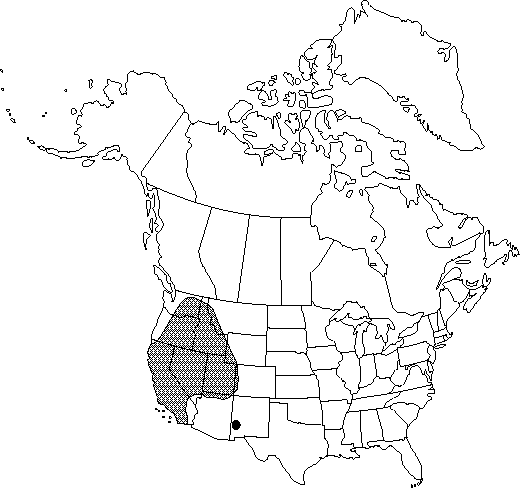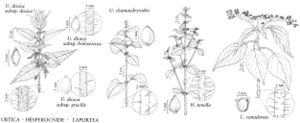Difference between revisions of "Urtica dioica subsp. holosericea"
Aliso 6: 68. 1967.
Selected by author to be illustrated
Basionym: Species Nuttall
Synonyms: Species S. WatsonVariety (Nuttall) C. L. HitchcockVariety S. WatsonVariety (Jepson) JepsonSubspecies (Nuttall) W. A. WeberVariety (Nuttall) Jepson
Treatment appears in FNA Volume 3.
FNA>Volume Importer |
FNA>Volume Importer |
||
| Line 41: | Line 41: | ||
}}<!-- | }}<!-- | ||
| − | --><span class="statement" id="st- | + | --><span class="statement" id="st-undefined" data-properties=""><b>Stems </b>softly pubescent, also with stinging hairs. <b>Leaf</b> blades abaxially sparsely to densely tomentose to moderately strigose, soft to touch, with stinging hairs, adaxially without or rarely with a few stinging hairs. <b>Flowers</b> unisexual, staminate and pistillate mostly on same plants. <b>2n</b> = 26.</span><!-- |
-->{{Treatment/Body | -->{{Treatment/Body | ||
| Line 47: | Line 47: | ||
|habitat=Alluvial woods, margins of deciduous or mixed woodlands, fencerows, waste places | |habitat=Alluvial woods, margins of deciduous or mixed woodlands, fencerows, waste places | ||
|elevation=0-3100 m | |elevation=0-3100 m | ||
| − | |distribution=Ariz.;Calif.;Colo.;Idaho;Mont.;Nev.;N.Mex.;Oreg.;Utah;Wash.;Wyo.;Mexico | + | |distribution=Ariz.;Calif.;Colo.;Idaho;Mont.;Nev.;N.Mex.;Oreg.;Utah;Wash.;Wyo.;Mexico. |
|discussion=<p>Urtica dioica subsp. holosericea is highly variable in leaf shape and degree of pubescence. The least pubescent plants appear to grade into U. dioica subsp. gracilis, and it is sometimes difficult to separate the two.</p><!-- | |discussion=<p>Urtica dioica subsp. holosericea is highly variable in leaf shape and degree of pubescence. The least pubescent plants appear to grade into U. dioica subsp. gracilis, and it is sometimes difficult to separate the two.</p><!-- | ||
--><p>The name U. serra Blume has been misapplied to this taxon.</p> | --><p>The name U. serra Blume has been misapplied to this taxon.</p> | ||
| Line 68: | Line 68: | ||
|habitat=Alluvial woods, margins of deciduous or mixed woodlands, fencerows, waste places | |habitat=Alluvial woods, margins of deciduous or mixed woodlands, fencerows, waste places | ||
|elevation=0-3100 m | |elevation=0-3100 m | ||
| − | |distribution=Ariz.;Calif.;Colo.;Idaho;Mont.;Nev.;N.Mex.;Oreg.;Utah;Wash.;Wyo.;Mexico | + | |distribution=Ariz.;Calif.;Colo.;Idaho;Mont.;Nev.;N.Mex.;Oreg.;Utah;Wash.;Wyo.;Mexico. |
|reference=None | |reference=None | ||
|publication title=Aliso | |publication title=Aliso | ||
|publication year=1967 | |publication year=1967 | ||
|special status=Selected by author to be illustrated | |special status=Selected by author to be illustrated | ||
| − | |source xml=https://jpend@bitbucket.org/aafc-mbb/fna- | + | |source xml=https://jpend@bitbucket.org/aafc-mbb/fna-data-curation.git/src/9216fc802291cd3df363fd52122300479582ede7/coarse_grained_fna_xml/V3/V3_791.xml |
|genus=Urtica | |genus=Urtica | ||
|species=Urtica dioica | |species=Urtica dioica | ||
|subspecies=Urtica dioica subsp. holosericea | |subspecies=Urtica dioica subsp. holosericea | ||
| − | |||
| − | |||
| − | |||
| − | |||
| − | |||
| − | |||
| − | |||
| − | |||
}}<!-- | }}<!-- | ||
-->[[Category:Treatment]][[Category:Urtica dioica]] | -->[[Category:Treatment]][[Category:Urtica dioica]] | ||
Revision as of 13:50, 27 July 2019
Stems softly pubescent, also with stinging hairs. Leaf blades abaxially sparsely to densely tomentose to moderately strigose, soft to touch, with stinging hairs, adaxially without or rarely with a few stinging hairs. Flowers unisexual, staminate and pistillate mostly on same plants. 2n = 26.
Phenology: Flowering late spring–summer.
Habitat: Alluvial woods, margins of deciduous or mixed woodlands, fencerows, waste places
Elevation: 0-3100 m
Distribution

Ariz., Calif., Colo., Idaho, Mont., Nev., N.Mex., Oreg., Utah, Wash., Wyo., Mexico.
Discussion
Urtica dioica subsp. holosericea is highly variable in leaf shape and degree of pubescence. The least pubescent plants appear to grade into U. dioica subsp. gracilis, and it is sometimes difficult to separate the two.
The name U. serra Blume has been misapplied to this taxon.
Selected References
None.
Lower Taxa
None.
